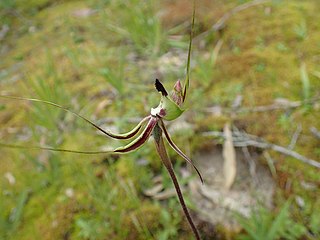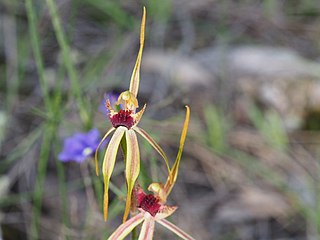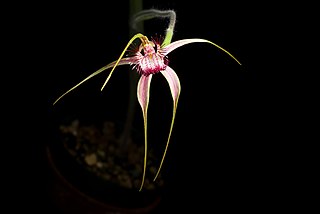
Acianthus, commonly known as mosquito orchids, is a genus of about twelve species of plants in the orchid family, Orchidaceae. Mosquito orchids are terrestrial herbs with a single, heart-shaped, usually ground-hugging leaf and one to many small, green, pinkish or purplish flowers on a fleshy stalk. They are found in New Caledonia, Australia and New Zealand.

Cyrtostylis, commonly known as gnat orchids, is a genus of five or six species of flowering plants in the orchid family Orchidaceae and is native to Australia and New Zealand. Cyrtostylis orchids often form dense colonies of genetically identical plants. They have a single heart-shaped leaf and a thin flowering stem with pale coloured insect-like flowers. The lateral sepals and petals are similar in size and colour but the labellum is shelf-like and conspicuous with two prominent glands at its base.

Cyrtostylis huegelii, commonly known as the western common gnat orchid or midge orchid, is a species of orchid endemic to Western Australia. It usually has a single rounded leaf and a flowering spike with up to fifteen pale green and dull red flowers with a purplish, shelf-like labellum. Some authorities regard C. huegelii as a synonym of Cyrtostylis reniformis var. huegelii.

Acianthus fornicatus, commonly known as bristly mosquito orchid or pixie caps, is a species of flowering plant in the orchid family Orchidaceae and is endemic to eastern Australia. It is a terrestrial herb with a single, heart-shaped leaf and up to ten translucent pinkish-red flowers, and is widespread and common in coastal and near-coastal areas.

Cyrtostylis reniformis, commonly known as common gnat-orchid, is a species of orchid endemic to eastern Australia. It usually has a single kidney-shaped leaf and a flowering spike with up to eight reddish flowers with a shelf-like labellum.

Acianthus collinus, commonly known as hooded mosquito orchid or inland mosquito orchid, is a species of flowering plant in the orchid family Orchidaceae and is endemic to south-eastern continental Australia. It is a terrestrial herb with a single, heart-shaped leaf and between two and nine translucent pinkish flowers with reddish markings and is found growing in colonies on sheltered slopes in open forest in on the western slopes of the Great Dividing Range.

Acianthus exsertus, commonly known as gnat orchid or large mosquito orchid, is a species of flowering plant in the orchid family Orchidaceae and is endemic to eastern Australia. It is a terrestrial herb with a single, heart-shaped leaf and up to 25 small, fine, dark brown flowers with pinkish and purplish markings and is found growing in sheltered places in forests in Queensland, New South Wales the ACT and Victoria.

Caladenia exstans, commonly known as the pointing spider orchid, is a species of orchid endemic to a small area in the south-west of Western Australia. It has a single, hairy leaf and one or two green, yellow and red flowers with a labellum which does not curl downwards but "points" forward.
Caladenia heberleana, commonly known as Heberle's spider orchid, is a species of orchid endemic to the south-west of Western Australia. It has a single, hairy leaf and up to three red, white and pale yellow flowers which have a white, red-tipped labellum.
Caladenia hiemalis, commonly known as the dwarf common spider orchid, is a species of orchid endemic to the south-west of Western Australia. It has a single, hairy leaf and one or two, cream-coloured flowers with a small, red-striped labellum. It has an early flowering period and its flowering is stimulated by summer fires.

Caladenia hirta subsp. hirta, commonly known as the sugar candy orchid or candy orchid, is a plant in the orchid family Orchidaceae and is endemic to the south-west of Western Australia. It has a single leaf and up to three creamy-white or pink flowers with brownish tips and a brown back.

Caladenia longiclavata, commonly known as the clubbed spider orchid, is a species of plant in the orchid family, Orchidaceae and is endemic to the south-west of Western Australia. It is a widespread and common orchid with a single, hairy leaf and one or two greenish-yellow, white and red flowers and which grows in the area between Perth and Albany.

Caladenia serotina, commonly known as the Christmas spider orchid, is a species of orchid endemic to the south-west of Western Australia. It has a single erect, hairy leaf and up to three white to cream-coloured and red flowers, although the relative amount of each is variable. It is one of the later-flowering spider orchids and occurs in the far south-west corner of the state.

Acianthus caudatus, commonly known as mayfly orchid, is a species of flowering plant in the orchid family Orchidaceae and is endemic to eastern Australia. It is a terrestrial herb with a single egg-shaped or heart-shaped leaf and up to nine dark purplish flowers with thin, spreading sepals and petals, often with a musty odour.

Diuris pulchella, commonly called the beautiful donkey orchid is a species of orchid that is endemic to the south-eastern part of the south-west of Western Australia. It has two or three leaves at its base and up to five bright yellow and mauve flowers described as "exquisite", "spectacular" and "attractive". It grows in shallow soil on granite outcrops near Esperance.
Caleana parvula, commonly known as the Esperance duck orchid is a species of orchid endemic to a small area near Esperance in the south-west of Western Australia. It has a single smooth leaf and usually only a single greenish yellow and red flower. It is distinguished by its small flower with the calli only on the outer one-fifth of the labellum. The only other Caleana species in Western Australia which is smaller is C. lyonsii.

Cyrtostylis oblonga, commonly known as the winter orchid or gnat orchid, is a species of orchid endemic to New Zealand. It has a single rounded leaf and a flowering stem with up to four pink or pinkish green flowers with a flat, oblong labellum.

Cyrtostylis robusta, commonly known as large gnat-orchid or mosquito orchid, is a species of orchid endemic to southern Australia. It usually has a single more or less round leaf and a flowering spike with up to seven reddish flowers with a shelf-like labellum.

Cyrtostylis rotundifolia, commonly known as the winter orchid or gnat orchid, is a species of orchid endemic to New Zealand. It has a single egg-shaped leaf and a flowering stem with up to four pink or pinkish green flowers with a flat, oblong labellum. It is very similar to Cyrtostylis oblonga and more investigation is required to determine if they are distinct from each other.

Acianthus cuneatus, commonly known as New England mosquito orchid, is a species of flowering plant in the orchid family Orchidaceae and is endemic to the Northern Tablelands of New South Wales. It is a terrestrial herb with a single, heart-shaped leaf and up to seven translucent greenish flowers with purplish stripes and is found growing in sheltered slopes in open forest.















